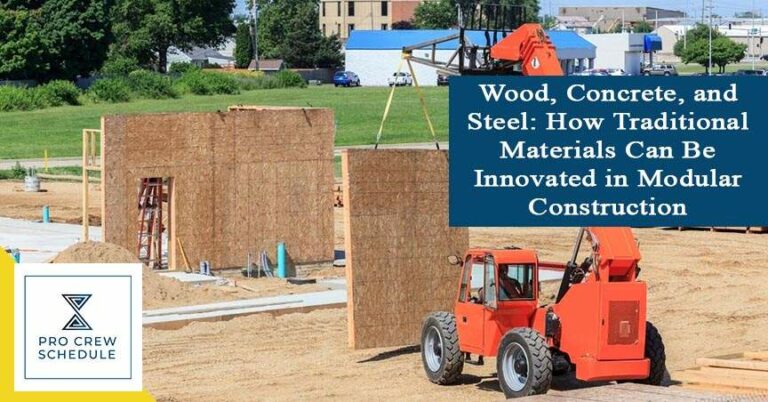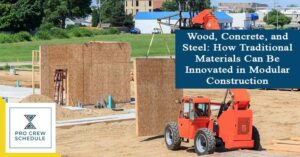Modular construction is revolutionizing the way structures are done today. With traditional construction seemingly having hit its peak, modular technology is set to take the construction industry to the next level in the years to come.
Traditional construction proved to be very inefficient, with over 57% of activities considered wasteful, leading to higher expenses and no added value in the overall project. Other industries that have incorporated new technology throughout the last few years have been experiencing a higher increase in growth. However, the construction business produces a productivity growth of only 1% per year in the last two decades. Knowing this, there is no better time to explore different innovations and embrace modernization than now.
Out With The Old, In With The New: Modular Construction
The attraction of modular structures is more than just the fresh and unique feel of constructing using modern methods. Modular construction uses the same materials as the conventional systems and is designed with the same set of building codes and standards but delivers buildings half the time and even lower cost. Amazing, right?
In today’s blog, we’ll discuss the difference between prefabricated and modular construction, the most common building materials used in modular buildings (which are very familiar), and the advantages of using modular components instead of their conventional counterparts.
Related: Modular Construction Technology: Notable Effects in Re-shaping Construction Industry
What’s the Difference Between Prefabricated and Modular Buildings?
In the construction world, people tend to interchange the terms modular and prefabricated buildings all the time. But do modular and prefab belong to the same spectrum in terms of construction processes? Are modular and prefab buildings just the same thing?
a. Prefabricated Buildings
Prefabricated or prefab construction refers to manufacturing prefabricated building components and modules in a factory-like controlled environment. It is an umbrella term for types of construction done in a factory and not in the job site like we are accustomed to.
Prefabricated construction is famous for its sustainability — there is no waste generated from manufacturing these modules as they can recycle extra materials in the factory. There is no site disruption as well since all the building components are made in the factory. In a nutshell, it is a cost-saving form of construction. Some of the types of prefabricated construction are panelized construction and modular structure construction.
Related: How Prefabrication Is Innovating the Construction Industry Today
b. Modular Buildings
Being one of the types of prefabricated construction, modular buildings are created in a factory. Modules that have been manufactured in the factory are transported and assembled on site. These modules are box-like units, when assembled, make up an entire building.
Modular structures are typically made using various construction materials such as cold-formed steel framing, wood framing, concrete, hot-rolled steel, or a combination of these assemblages. Modular construction uses an inside-out approach in their processes— frames are constructed as fitted boxes, flat planes, and then finished from inside out.
The bottom line is this: all modular structures are prefabricated, but prefabricated structures may or may not be modular. Again, modular structure construction is just one of the many types of prefabricated construction.
What Are The Top 3 Building Materials Used In Modular Construction?
Wood, concrete, and steel: Each has been used in different forms of traditional construction for many generations (with steel being the newest addition), each providing respective benefits and difficulties to consider. These three very familiar building materials have their role in the modular construction world as well. The modular construction process allows slightly contrasting benefits and challenges, and the modular design of a specific construction project can determine what type of material needs to be used in construction.
Below, we explore each building material’s use in modular construction and their advantages compared to their traditional counterparts. Let’s start.
1. Wood
Since the beginning of the construction discipline, the seventeenth century to be exact, wood has been used in modular construction. Wood, as a modular material, is beneficial due to its winning qualities such as: easy to work with either by hand or machine, biodegradable, low in toxicity, easy to reuse and recycle, and most importantly— affordable.
a. Lighter in Weight Than Concrete and Steel
As you can imagine, wood is lighter to work with than concrete or steel (with some exceptions to aluminum). Meaning, it is easier for construction workers to work with it whether they assemble a building with wooden modular components with the help of machinery or by hand.
b. Recyclable and Sustainable
As we all know, wood is an eco-friendly material in a variety of ways. Given ethical harvesting and appropriate forestry practices, wood can be a very sustainable material in your construction. Additionally, it is also reusable. When it’s time to disassemble a structure or just a part of it, healthy wood can still be reused. Wood naturally decomposes when untreated, making it less harmful to the environment no matter how it is handled.
With its ability to be laminated, manipulated, or reused, wood will remain a sustainable building material in modular construction.
c. Very Durable
Wood is a very durable construction material and is ideal for small to medium-sized structures. While modular construction made of wood is only used for single-storey structures, further advancement in technology will enable multi-storey wood building in the near future.
Moreover, as an installed wooden module dries as part of a structure, it increasingly hardens. The hardening process then increases the overall durability and strength of a structure.
d. Offers Better Insulation
Lastly, modular construction projects created with wood offers additional insulation and less energy waste. Generally, wood is better insulation than concrete or steel since its cellular structure allows it to maintain heat energy. Additionally, a wooden structure with added insulation will help conserve energy bills during the construction operations and after the build and help minimize electrical shocks when electrical problems arise.
Some of the modular components made of wood are the following:
- Roof trusses
- Floor and Wall Panels
- Wood I-Joists
- Engineered Laminated Beams
- Plywood
- Composite Panels
2. Steel
Metals can be described as hard, conductive, ductile, strong, precise, and typically categorized as ferrous and non-ferrous metals. Ferrous metals are usually used in structural applications since they are strong, durable, and ductile due to their high iron content. They can be treated with coatings like galvanizing to avoid corrosion when exposed to weather and other external factors. Non-ferrous metals are used in cladding and roofing applications and are naturally corrosion-resistant.
Although steel is a slightly expensive material than concrete and wood, steel is more economical when building high-rise structures, long-span structures, and complex designed buildings because of its speed and strength in construction.
a. Highly Fire Resistant
One significant advantage of using a steel-frame building is its non-combustibility. This provides a safer space for employees and inhabitants; potential damage caused by fire will be limited.
b. Long-Lasting and Durable
If adequately protected from corrosion, steel can survive the severest of weather conditions and last long. With the new technology of lightweight metals such as aluminum, more modular construction projects will benefit from building multi-material construction projects that might feature wood and metal frames. Modular steel-framed buildings are ideal for permanent modular buildings.
c. Easy to Transport and Tear Down
The way steel frames can be bolted and fitted together makes this material more convenient to dismount than the other alternatives. If you want to replace, remove, or add a new modular piece onto your building, it’s often effortless with steel construction.
Below are some of the modular components made from steel:
- Lumber or in tandem with wood framing
- C-shaped sections for studs and rafter
- Channel sections for top and bottom joist headers and wall plates
3. Concrete
Traditional on-site construction involves concrete usually mixed from specific Portland cement, sand, an aggregate of various sizes, and water. It goes through the hydration process, which hardens and cures the concrete to attain its specified strength (i.e., 5000 psi). Concrete depends on steel reinforcement for its tensile strength. Concrete is labor-intensive since formwork must be set in place, concrete poured into the formwork, and then troweled and smoothed to finish the process.
a. Very Solid Material
Once in place, concrete modular buildings are heavy and solid buildings. It’s common to see core parts of a modular building utilize concrete material while supplementing with wood or steel for the remainder of the structural framework.
b. Good For Utility Buildings
Buildings made from concrete make for significant outdoor or utility buildings.
Modular structures and components made from concrete are the following:
- Concession buildings
- Shower facilities
- Utility buildings
- Walls that are fabricated with concrete masonry units (CMUs) or high strength precast concrete
Key Takeaway
It is true that embracing new things come with fear and uncertainty since it is easier to stick to what’s familiar and proven, but as the construction industry grows— so should our methods. Manage your transition to modular technology with a trusted construction management software, like Pro Crew Schedule, to help you stay on top in terms of your scheduling, inventory, task management, and more.
Growth is not always as easy and instant, but with the help of the right people and tools, the process will feel effortless from this point on and beyond.







